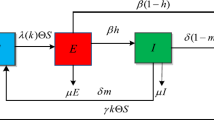Abstract
Rumor, with the fast speed of transmission, may bring us panic, even economic loss. Thus, it is significant for us to take effective steps to control the rumor spreading. Unfortunately, most of the existing works ignore that the spreading probability is not a constant, but depends on the number of spreaders currently. That is to say, the more spreaders, the larger spreading probability. In order to overcome this shortcoming, in this paper, we propose a novel susceptible–infected–removed (SIR) rumor spreading model with the influence mechanism, called SIR-IM, which first incorporates the number of current spreaders into the spreading probability. Then, it employs time function to describe the rate of people from spreader to stifler as time goes on. Moreover, we not only derive mean-field equations to describe the dynamics of our SIR model, but also give theoretical analysis. Numerical simulations are conducted on social networks, which show that the influence mechanism can accelerate the rumor spreading.








Similar content being viewed by others
References
Angstmann CN, Henry BI, McGann AV (2016) A fractional-order infectivity SIR model. Phys A 452:86–93
Bajardi P, Poletto C, Ramasco JJ, Tizzoni M, Colizza V, Vespignani A (2011) Human mobility networks, travel restrictions, and the global spread of 2009 H1N1 pandemic. PLoS ONE 6:e16591
Chen F, Griffith A, Cottrell A, Wong YL (2013) Behavioral responses to epidemics in an online experiment: using virtual diseases to study human behavior. PLoS ONE 8:e52814
Daley DJ, Kendall DG (1965) Stochastic rumours. IMA J Appl Math 1:42–55
Fenichel EP, Kuminoff NV, Chowell G (2013) Skip the trip: air travelers’ behavioral responses to pandemic influenza. PLoS ONE 8:e58249
Ferguson N (2007) Capturing human behavior. Nature 446:733
Franz M, Alberts SC (2015) Social network dynamics: the importance of distinguishing between heterogeneous and homogeneous changes. Behav Ecol Sociobiol 69:2059–2069
Funk S, Salathé M, Jansen VAA (2010) Modelling the influence of human behaviour on the spread of infectious diseases: a review. J R Soc Interface 7:1247–1256
Kumar A, Mehrotra KG, Mohan CK (2018) Algorithms for fast estimation of social network centrality measures. Int J Big Data Intell 5:216–227
Kermack WO, McKendrick AG (1991) Reprinted in Bull. Math Biol 53:33
Rizzo A, Frasca M, Porfiri M (2014) Effect of individual behavior on epidemic spreading in activity-driven networks. Phys Rev E 90:042801
Sudbury A (1985) The proportion of the population never hearing a rumor. J Appl Probab 22(2):443–446
Wang YQ, Yang XY, Han YL, Wang XA (2013) Rumor spreading model with trust mechanism in complex social networks. Commun Theor Phys 59:510
Wang W, Tang M, Zhang HF et al (2014) Epidemic spreading on complex networks with general degree and weight distributions. Phys Rev E 90:042803
Wang T et al (2018) An information spreading model based on online social networks. Phys A 490:488–496
Xia L, Jiang G et al (2015) Rumor spreading model considering hesitating mechanism in complex social networks. Phys A 390:295–303
Ya-Qi W, Jing W (2017) SIR rumor spreading model considering the effect of difference in nodes’ identification capabilities. Int J Mod Phys C 28:1750060
Zan Y (2018) DSIR double-rumors spreading model in complex networks. Chaos Solitons Fract 110:191–202
Zhang Y, Zhu J (2018) Rumor spreading model in complex networks. Phys A 398:43–55
Zhang Y, Xu J, Wu Y (2018) A fuzzy rumor spreading model based on transmission capacity. Int J Mod Phys C 29(02):1850012
Zhao LJ, Wang Q, Cheng JJ, Chen YC, Wang JJ, Huang W (2011) Rumor spreading model with consideration of forgetting mechanism: a case of online blogging LiveJournal. Phys A 390:2619–2625
Zhao L, Wang J, Chen Y et al (2012) SIHR rumor spreading model in networks. Phys A 391:2444–2453
Zhao LJ, Xie WL, Gao HO, Qiu XY, Wang XL, Zhang SH (2013) A rumor spreading model with variable forgetting rate. Phys A 392:6146–6154
Zhao L, Wang J, Huang R (2015) Immunization against the spread of rumors in homogenous networks. PLoS ONE 10:e0124978. https://doi.org/10.1371/journal.pone.0124978
Zhu L, Wang Y (2016) Rumor spreading model with noise interference in complex social networks. Phys A 469:750–760
Acknowledgements
This study was funded by by the Nature Science Foundation of China (Grant Numbers 61502281, 71772107).
Author information
Authors and Affiliations
Corresponding author
Ethics declarations
Conflict of interest
All authors declares that they have no conflict of interest.
Ethical approval
This article does not contain any studies with human participants or animals performed by any of the authors.
Additional information
Communicated by C. Jiang.
Publisher's Note
Springer Nature remains neutral with regard to jurisdictional claims in published maps and institutional affiliations.
Rights and permissions
About this article
Cite this article
Qiu, L., Jia, W., Niu, W. et al. SIR-IM: SIR rumor spreading model with influence mechanism in social networks. Soft Comput 25, 13949–13958 (2021). https://doi.org/10.1007/s00500-020-04915-7
Published:
Issue Date:
DOI: https://doi.org/10.1007/s00500-020-04915-7




